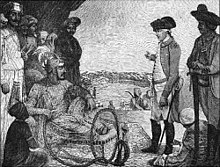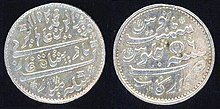A dagger from the Mughal Empire with hilt in jade, gold, rubies and emeralds. Blade of Damascene_steel inlaid with gold
A panorama in 12 folds showing the procession of the last Mughal Emperor Bahadur Shah II to celebrate the feast of the Eid ul-Fitr in 1843.
The Mughal Emperor Shah Alam II negotiates territorial changes with a representative of the British East India Company after the Battle of Buxar.
Mir Sayyid Ali, writing a commentary on the Quran, during the reign of the Mughal Emperor Shah Jahan.
A silver coin made during the reign of the Mughal Emperor Alamgir II.
Mughal troopers purchase copper utensils in the Bazaar
.
Mughal, Ottoman and Safavid architectural concepts were incorporated into the design of the Taj Mahal
A Mughal War elephant guarding the gateway to the Grand Mosque in Mathura.
The Bazaar outside the Wazir Khan Mosque in Lahore.









